

Benjamin Foust - NanoJapan 2014
Rice University
Major: Physics & Mathematics
Class Standing: Sophomore
Anticipated Graduation: May 2016
NanoJapan Research Lab: Saito Lab, Prof. Riichiro Saito, Tohoku University
NanoJapan Research Project: ![]()
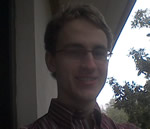

Why NanoJapan?
NanoJapan, to me, is an opportunity to conduct significant research while learning about a culture different from my own, which I see as being extremely beneficial. For one, having to learn how to conduct my research while using a language I am less familiar with will be a great experience, as it will help me to better understand how to communicate with those I work with in ways that everyone can comprehend regardless of background. This is an essential skill for engineering and physics students as these careers will often require you to work with people of different cultures.
I applied to this program because it will allow me to build connections with current researchers on an international level. These kinds of connections are invaluable and will help me pursue my career by giving me a network through which I can communicate, whether to share information or to ask for advice. I am greatly looking forward to seeing cultural differences between Japan and America, both in a lab setting and on a community setting.
My goals for this summer are to:
First off, as I suspected, there are a lot of Japanese people in Japan (surprising, I know). More interesting is that almost every sign in Tokyo, especially those with directions, has both Japanese and English on it. Some of them even have Korean. I was not expecting this at all, and it has made navigating Tokyo during the first week so much easier. After speaking to the KIP students, it seems in the last year or so there has been a large push for signs with English in order to prepare for the 2020 Olympics in Tokyo. Another surprise came from my expectations of Tokyo being very similar to New York City. During the day, this is largely true (though Tokyo is cleaner, bigger, and a bit more crowded). However, at night, the two are very different. Tokyo’s subway is NOT 24/7, it shuts down around midnight. Most places also close down by 10 PM unless you are in a nightlife district like Shinjuku or Akihabara. The sun also seems to comes up at like 4 AM (I guess that’s why it’s the land of the rising sun).
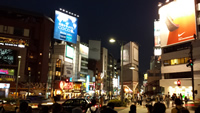
The city is beautiful at night. You can also see many of the signs have English.
Overall, Tokyo has been a blast thus far. Most of its residents understand basic English and most restaurants offer English menus. The city seems to be crime free, which I was skeptical of before coming here. I suppose my biggest surprise was the sheer size of Tokyo. It’s HUGE!!! Each district is the size of a small town (regular sized town in the case of the big districts), and there are an extremely large number of districts. We’ve been going out every afternoon to explore and we haven’t even scratched the surface.
The language classes are very intensive and long, but the AJALT sensei’s are very understanding and patient with us. Fortunately, Japanese seems to be grammatically simple with few exceptions to the rules they put forth (except for counting, ugh). So far the most important thing we have learned is probably how to pronounce English words in a Japanese accent. Japanese incorporates a lot of foreign words, so katakana is very important. My strategies for learning Japanese out of the classroom involves putting off the homework until the night so that the separated studying sinks in better. Other than that, my strategies have mostly come from Vernon who is making a very good effort to learn the language. We have been practicing by doing things like asking passersby in Japanese to take our photo at whenever we are at a nice photo area, as well as attempting to order food in Japanese (with the help of more advanced users like Naoki).
I suppose my biggest question is: what is the attitude of most Japanese people to gaizin (foreigners)? Often times we find ourselves being the loudest at restaurants or blocking people’s way in the street, or otherwise inadvertedly being somewhat obnoxious in regards to those around us, but they almost never complain or even give us dirty looks. Mostly they just smile gently or say Sumimasen and keep on walking. Are they simply treating us differently because we are foreigners or do they treat everyone this way?
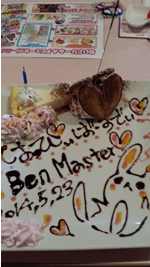
The gift they gave me when we went to celebrate the day after my birthday. Akihabara was…interesting.
Research Project Overview at Saito Lab, Prof. Riichiro Saito, Tohoku University
My project is the theory project. The exact topic has not been decided yet, but will involve solid state physics, which I have been reading up on. Possible topics Saito-sensei has mentioned included carbon nanotubes, grapheme, and plasmonics. Carbon nanotubes are a 1D system, graphene is 2D, and Plasmonics involves nanoparticles so I’m assuming that the system is considered 0D (It’s that or 3D). Plasmonics is a property of metal nanoparticles, while carbon nanotubes and graphene can be either an insulator or semiconductor depending on conditions such as chirality. Plamonics is a phenomenon of metallic nanoparticles. When light shines on these nanoparticles, the electrons in the particle resonate with light of a certain range of wavelength (depending on the metal). The oscillation of the free electrons is called plasma oscillation, and this produces a plasmon. Similarly, graphene and carbon nanotubes have the phenomenon of phonons which arise from lattice vibrations. As my specific topic hasn’t been decided, I’m uncertain of what properties I will be studying or what applications the material will have. I know Plasmonics has applications in solar cells and detection.
The first thing you notice on the subway is almost no one talks, or makes noise in general for that matter. The only time you see people talking is during midday when they are traveling in a small group, and even then it’s only whispering. Talking on the cellphone is pretty much strictly forbidden. Speaking of phones, pretty much everyone is playing games or listening to music the entire time (with headphones in of course). Everyone is also always looking down, even if they aren’t on their phones. Making eye contact seems to be very bad.
From what I have noticed, what is considered polite is essentially the same as in America, but more situations require you to be polite. Basically, politeness is the norm here. It is alright to act more casual in private with friends or people your age, or with people who are intoxicated (in fact, most of these social rules can be ignored by drunk people and it is forgiven as long as it is late at night, judging from our experiences of meeting intoxicated Japanese people while exploring the night life of places like Shinjuku).
Public transportation in Japan is pretty much ideal. With things like the Pasmo card, getting on the subway, trains, buses, and even buying drinks from vending machines just takes a tap of your wallet against the sensor. Transportation is also quite cheap. The night we had to take a taxi (the metro closes at midnight), it cost us about 3000 yen ($30) to get back to Sanuki, while getting to the area on the metro cost two, maybe three dollars.
The majority of the differences I have noticed are simply practical. For example, slurping noodles is not considered bad manners, and is in fact considered the ‘correct’ way to eat noodles, which makes eating ramen and udon so much more enjoyable. Many of the differences involving politeness that I’ve noticed aren’t actually all that different from my experiences living in the southern part of the states, though not everyone in the south demonstrates such standardized politeness anymore.
One of the values we discussed was the group mentality of the Japanese people. This is not only about collaborating in a group, but for putting the comfort of the group before your own comfort. This is demonstrated on the subway by the way people are quiet to not disturb those around them. Another value the Japanese had is pragmatism. This is demonstrated by how the people on the subway are using this time to do something. Whether it’s playing on the phone, listening to music, or sleeping, they are making use of the time as best they can, where as I usually pick a spot on the wall and look at it while twiddling my thumbs.
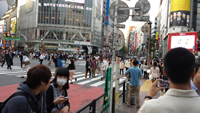
An example of how considerate Japanese people are towards the well being of the group: they wear masks when sick to prevent the spread of illnesses.
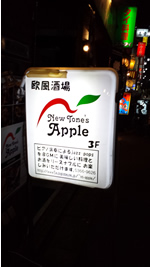
New Tone's Apples: Not sure if this was intentional or not, but I thought the joke was great.
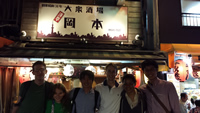
Out with Japanese Friends: A picture of us with our newly made KIP friends, after they showed us how Japanese people enjoy a night out.
Intro to Nanoscience Lectures
The first lecture given by Professor Bird was an overview of band gap engineering and technology. First he gave several examples of applications of band gap engineering. Then he introduced us to some Solid-state physics, mostly the idea of energy bands and band gaps, showing us the differences between metals, semiconductors, and insulators, as well as the idea of electron-hole pairing. He went on to talk about how materials with different band gaps can be combined at junctions, as well as the properties of these different types of junctions. Lastly, he talked about the applications of electronics which take advantage of these junctions.
The second lecture focused on the material graphene. Once again he began with a few examples of the applications of graphene, and then went on to explain Moore’s Law and its implications for the information processing industry. The majority of the lecture was discussing the properties of graphene and why it has these properties, as well as some of the problems with graphene, all of which are addressed in the questions at the end of this section.
This week guest lectures were given by Maruyama-sensei and Ishizaka-sensei. Maruyama-sensei’s lecture was about graphene and carbon nanotube fabrication. It all involved work he had been doing in his lab, and he included several useful diagrams. Most of the lecture was very technical and difficult for me to follow. Ishizaka-sensei also talked about her lab work, but I found her account of her experiences as a woman in research and academia in Japan to be much more interesting. I was surprised to hear that both her coworkers and the school administration were extremely supportive of her, almost overwhelmingly so. This means that the lack of female researchers and professors in Japan is mostly due to a cultural stigma at a young age rather than discrimination in the work place. This is actually must harder to fix, and would take a lot of time to change this stigma.
Kyushu was a beautiful area. Mt. Aso in particular was stunning, and the view of the surrounding area was amazing as well. Afterwards, we went to visit the Japanese kindergartens, who were absolutely adorable. They were very amazed at how tall I was. Next we went to watch Kagura, and Vernon got to be a part of it! It was very exciting. Also, while at the Shinto temple, I ‘had my fortune read’ and got the extremely lucky fortune. I’m definitely keeping that as a souvenir! The next day we went to the Gokase Highschool, and got to make grass flipflops (I don’t remember what the actual name for them is), and then did our science game with them, demonstrating magnetic forces. We then went to our homestays, which I’ll talk about later. The next day we went with the high school students to a famous cave with a Shinto temple built around it. I got a lot of interesting pictures.
I would say getting to spend time with the high school students had the greatest impact on me. I feel like one of the most important parts of a culture is what it is like growing up in that culture, since how you develop in your youth shapes the kind of person you will be as an adult. Spending time with the high school students gave me a lot of insight into what it was like being a Japanese adolescent.
Honestly, I didn’t really have any expectations going into Kyushu. Not that I wasn’t excited for it, I was just so overwhelmed by Tokyo already that I never really got a chance to sit down and think about how the Kyushu region might be even more different than what I had been experiencing.
My homestay family are the owners of a small inn. There were the two grandparents, two parents, and a toddler. They spoke no English, which made holding a conversation difficult, but were very friendly. One of the first things we did was visit a fish farm. They showed us the different kinds of fish and what kind of environment they were kept in. Afterwards, they prepared a very traditional Japanese dinner for us. This dinner included raw fish, skewered fish, and soup with a big fish head floating in it. After dinner, we presented our omiyages. The granddaughter, Kaho-chan, was at first very shy around us, but after we gave omiyages (mine was chocolate), she was very friendly. Next we helped clean our dishes (they were very glad we offered), and then went to bed. In the morning, after eating breakfast, they drove us up the mountain to go sight-seeing. At this point, Kaho-chan liked us so much that she came along with us. We went to see the top of the mountain where the ski slopes would be in the winter. You could see the surrounding mountains, and the scenery was beautiful. We got several great pictures while there. Afterwards, it was time to return to the Gokase school. We said our good byes and thanked them for their hospitality. From this experience, I learned how to relate to others even when there is a devastating language barrier. I feel this experience will help me make all sorts of friends and colleagues in the future.
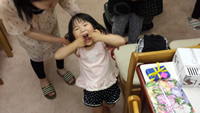
Just Kaho-chan and her hijinks.
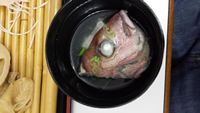
Oh, hello, didn’t see you there Mr. Fish-sama.
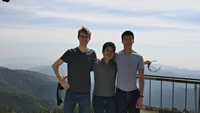
Us on top of the mountain with a spectacular view.
Overview of Orietnation
I actually found the science lectures to be most helpful, especially those by Kono, Bird, and Stanton-sensei. Although there was quite a bit of overlap in material covered, getting familiar with some solid state physics, which I had never seen before, is very important coming into my theory project.
The most helpful part of learning Japanese was immediately learning how to pronounce English words with a Japanese accent. This skill has come in handy countless times already.
I’d say that politeness over everything is the most important thing I’ve picked up so far. It really allows the Japanese people to be warm to you, when otherwise you would be just another passerby.
One question I still have about Japan: Why the rainy season? Why in the summer? WHYYYY WHILE I’M HEEEEERRRRRE NOOOO
Intro to Nanoscience Lectures
Stanton-sensei’s first lecture was about some basic solid state physics. He introduced us to energy band gaps, and the different properties of junctions of semiconductors. Then he started talking about applications in Light Emitting Diodes (LEDs). He showed us how the power efficiency of LEDs has been increasing steadily over time. I found it very interesting that it took a long time to develop white light LEDs. His second lecture was about lasers and spectroscopy. Specifically it was about Femtosecond spectroscopy which uses very high energy but extremely short duration lasers to probe materials. This method has many advantages, but the largest disadvantage is that if the energy is too high, you start running into problems with the uncertainty principle, as well as damaging the material.
The only guest lecture this week was Otsuji-sensei. His lecture was focused on Graphene. First, he talked about the energy band structures in Graphene, and showed us some of the theory and equations involved in calculating the energy bands. Much of this was also talked about by Stanton-sensei. He talked about electron and hole mobility. He then talked about the various techniques for the synthesis of graphene. Lastly, he started talking about lasers, starting with quantum cascade lasers. He then showed us how graphene could be used to make lasers in the THz range. It was very interesting.
The first day wasn’t quite like what I expected. First, I was picked up from Urban Castle Kawauchi by Thomas-san. He showed me how to get to the lab, and explained the bus stops and times to me. After getting to the lab, I was introduced to Saito-sensei, as well as the members of slab (saito lab) and slabg (saito lab gaijin). Then, we spent the next hour and a half getting me set up in my office with a desktop and giving me a user account on the lab server. After that, I had lunch with lab members, and began looking into material regarding graphene and plasmonics.
My main mentor is Shoufie-san. He is not from Japan, but is an international student (I’m pretty sure he is Indonesian). He is very friendly and helpful. There is also Thomas-san, who is Brazilian, and is more casual with me, and great to make small talk with. A few others, such as Pourya-san and many of the Japanese members of the lab are a little harder to communicate with, but it is manageable. Everyone in the lab speaks English to some extent. This varies from entirely fluent to very broken and hard to understand. However, I don’t think my ability to speak Japanese will affect my ability to work in the lab. After asking Saito-sensei about voluntary language classes, he told me it would probably be unnecessary, and to make sure not to spend so much time on it that it interferes with my research (Saito-sensei is very pragmatic).
I am living in Urban Castle Kawauchi. They have a large kitchen area with stuff for making food, as well as plenty of refrigerator space. The actual room is much smaller than the dorm I’m used to in the States, but a little bigger than the Sanuki Club (I think, it’s not as long but is much wider). The only real complaint I have is that the bed is literally like sleeping on a rock, but fortunately I am a very heavy sleeper. On the bright side, there is free wifi in the common rooms on the first floor, and my room just so happens to be directly above one of the common rooms, so I get okay-ish quality internet connection for free in my room.
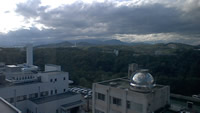
A view from my office hallway. It’s really pretty when it’s not raining!
PS. I spent some time practicing in the States before coming to Japan, but it was apparently not enough. I was still destroyed at ping pong by the rest of the lab. It was a lot of fun though.
Research Update
My exact project has not been decided as of yet, but Saito-sensei has several plans for me. Currently he is having the other lab members give me two lectures a day (with homework assignments) on various topics, including plasmonics and the dielectric function, deriving the wave equation, differential operators in curvilinear coordinates, differential equations, partial differential equations, programming with mathematica, using gnuplot to graph energy dispersions of graphene, and deriving the energy dispersion of graphene, as well as other topics. It has been very intensive, but I feel pretty comfortable with what I have learned thus far and the lab members are always there to answer questions. I also meet with Saito-sensei once a day to talk about what I have learned, and he makes sure the lab members have taught in such a way that I understand the topic. Once this period of lecturing and homework is over, Saito-sensei will have a better understanding of what I am good at and we will decide on the course of my project from there. Fortunately, many of the topics we cover are things I have already seen before (all of the math we have covered I have done at Rice), which helps.
Alright, so the only relevant experience I can think of is an incident that happened while we were at Mt. Aso. It didn’t help that we ate at an all-you-can-eat buffet. So I saw all the different kinds of food they had there, and since I have been wanting to try all sorts of weird and unusual foods in Japan, I grab a little bit of everything. Naturally, this makes my tray quite full. Of course, I didn’t finish everything I got. Little do I know, many Japanese apparently find it offensive when you don’t finish your meal. My good intentions were that I was trying to be open minded by trying lots of new foods that foreigners might think are disgusting based on looks (as well as find the secretly super tasty foods). Packard-sensei was saying that it is disrespectful to waste food when there are those who lack proper meals. It ended up being resolved after I finally finished most of it (despite starting to feel a little sick), and apologized to Packard-sensei. Next time I’m only going to take two or three types of food at a time, no matter how good the rest looks. Then I can come back for seconds or thirds.
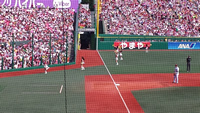
A picture from the ballgame with Santos-sensei, as promised. It was really strange seeing cheerleaders at a baseball game.
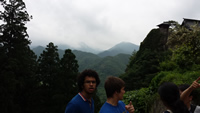
A picture from the Sendai squad’s weekend trip to Yamadera, a beautiful Buddhist temple in the mountains. The person with Vernon is Zidane, a friend who is also staying at Urban Castle with us. We play a lot of ping pong together.
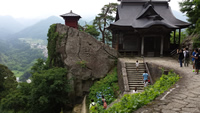
As you can see, it was really beautiful. Unfortunately, I didn’t get a shot of the whole group on my phone (Vernon did though). The group was myself, Vernon, Ramya, Santos-sensei, two of Ramya’s lab mates, Zidane, Umo, Milan, Chat, and a few others also from Urban Castle. It was a blast!
Research Project Update
So far, my project still hasn’t been completely determined yet, but we are narrowing down the options for the goal of the project. It is definitely going to involve graphene and plasmons. It sounds like I will either be looking into surface plasmon polaritons (SPP), which are plasmons that have been coupled with light waves, or into plasmons generated by an alternating current at an interface. Another possibility that Saito-sensei mentioned is looking into trying to explain why plasmons’ group velocity is so much slower than that of electrons, which is known purely from the data and a good explanation has not yet been fully investigated.
There have been a couple of difficulties so far, since the material that the other lab members have been giving me lectures on is very advanced. However, since I meet with Saito-sensei daily and must regurgitate what I have learned at each lecture, we usually catch what I have been struggling with. If necessary, he calls down the student who gave the lecture and we relook at the subject. This usually happens when there is a discrepancy between what Saito-sensei wanted me to learn in the lecture and what the student thought would be relevant for me. What generally happens is I grasp the math and reasoning of the topic being discussed, but have a little trouble getting the “big picture”, sometimes due to a language barrier and sometimes due to time constraint of the lecture.
Unfortunately, the only result to speak of is the large stack of notes I have accumulated over the past two weeks. I am currently working on making a vector plot of a dipole produced by an incident light wave as part of my combined homework of mathematica plotting and the finite element method. I will try to include this in the next report once it is finished.
The main rule of the lab is communication. You must respond clearly and in a timely manner. My communication at the beginning of the research period was not so great, but has been steadily improving. When addressing one another, if it’s one of the international students and we’re speaking one to one, then we are very casual. With Saito-sensei or the other Japanese students, we are more formal and add the proper Japanese endings. If there is a disagreement, we basically just go by seniority.
I knew this from my Alumni mentor, but there is a lot more math and theory in my project than what the Orientaion lectures prepared us for (not surprising since mine is the theory project). I must know the “story” or else the rest won’t make sense. I think effort is more valued in Japan for academic research, while my impression of American research is that, while hard work is appreciated, fast, correct, and useful results are most highly valued.
My experience so far has been much less relaxed. Working in Japan, you are expected to be there early and stay as long as you need to, every single day. In addition, there is always something to be working on. My experience in America was definitely more of a ‘put in whatever effort you feel like’ kind of atmosphere. I had to go to the different lab members in order to find things they needed help with. I prefer my Japanese experience so far, as I feel like I am accomplishing more.
Choose an anecdote from your experiences in your lab at this point that you think best illustrates the rules of your lab.
“You must know the whole story, or you will be wandering in dark, unable to find ramen shop.”
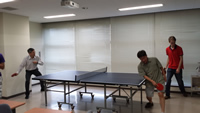
Ping Pong showdown. Kono-sensei has mad skillz.
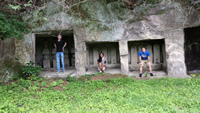
The Sendai Squad Visiting Matsuhima. Hopefully we aren’t desecrating anything.
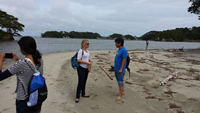
Us at the remote beach we found. Fun fact, I nearly stepped on a big snake minutes early, scaring the both of us to near death.
Research Project Update
Over the past week, we have switched from lecture style to discussion style, so I am now making progress on my own and then discussing with Shoufie-san what I have done and what I am stuck on, rather than the lab senpais teaching me a variety of topics that may or may not be relevant to my research. I have finished reproducing the calculations that give a faster than measured value for the velocity of plasmons in graphene.
I think my biggest personal accomplishment has been making friends outside of my lab. I was expecting to have trouble with this, but it has been surprisingly easy. I have made several friends at my dorms, through playing ping pong and other means, and we often go to explore the city. Recently, I have also started making friends from other labs. For example, Nick is a mutual friend of Shoufie-san who I met after we encountered each other on the campus bus. Turns out we work in the same building and he is also from America. Another small accomplishment I guess is that Saito-sensei hasn’t found me on the street begging for food. He occasionally tells me that preventing this is his ultimate goal, to which I nervously laugh because I can’t tell if he is joking.
My biggest challenge has definitely been trying to meet Saito-sensei’s expectations every single day. Since I meet with him daily, I have to present to him what I’ve been working on each day. This not only means that I can’t slack off, but also that I have to know what I’m doing well enough to explain it clearly and thoroughly to another person. The Saito lab has never worked with plasmons before, so he always has many difficult questions for me, and if I can’t answer them, we have to call a grad student down and see if the problem was with their explaining or with my comprehending. Whichever the reason is, this is something I try very hard to avoid, so I always put a lot of effort into preparing for and answering his questions.
I feel as though my research hasn’t necessarily progressed as far as many of the other NanoJapan students’ projects might have gotten so far. Spending the first 2 weeks entirely on lectures and homework means that about one fourth of my research time has been eaten up. However, in the past two weeks, I have come quite far, especially considering the most recent week was only 3 days. I am not sure if I can get the results we want in the remaining time, but if I keep up this rate, I’ll at least have investigated several possible leads that could potentially explain the question of the project.
I am really looking forward to seeing everyone again during the Mid-Program Meeting, and hearing how their projects are progressing.
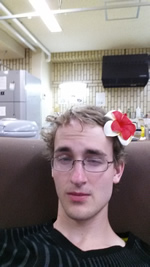
Me rockin the Hawaiian hairpin I got from Sarah-sensei.
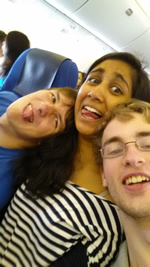
The Sendai Squad is on our way to Okinawa and ready to do battle with the other, inferior city groups.
Research Update
I have finished deriving the dispersion relation for surface plasmons in a single interface of graphene surrounded by dielectrics, and created plots of both the frequency and the group velocity of the surface plasmons as a function of wave vector. I created a powerpoint detailing this derivation, excluding the derivation for the Drude conductivity (I haven’t had time to add that part yet). All of this has been double checked by Saito-sensei. I have also started looking into two interfaces of graphene, and the case where one of the dielectrics is replaced with a metal. These are similar to my previous work but with a lot of added arithmetic.
My biggest setback is probably that I have been very slow at entering equations onto computer programs like Powerpoint, which were not created with ease of mathematical input in mind. It has shortcuts for all the symbols but learning them has been quite slow.
Learning Japanese this summer has been difficult, but very rewarding. Coming out of orientation, I felt like I had learned more Japanese in three weeks than I had been able to learn of German in a full semester. Unfortunately, with my discussions taking place in the mornings, I cannot take the voluntary Japanese class at Tohoku as it occurs at the same time as my meetings with Saito-sensei. However, I have been learning little bits in the lab from Saito-sensei and the three Japanese grad students, though it can’t really compare to how much I learned during orientation.
I think one of the most challenging experiences we’ve had was one of outings with Prof. Mike Santos, who was a visiting researcher at Tohoku University this summer. The restaurant we ate dinner at was a fairly small place, that ended up not having an English menu. The main problem was the Japanese menu had no pictures on it either, which completely flabbergasted us. We ended up asking the waiter for recommendations or to explain items. Although his English was only about as good as our Japanese, we managed to place our orders without being too worried about getting something repulsive. Hand gestures, I have found, are a big help.
The most effective technique for me is just simply to keep trying to communicate. Because my lab is very international, my contact with native Japanese speakers is somewhat limited, but I try to make up for this by talking with Japanese students at my dorm. Now that I know even just a little Japanese, I’ve found it very useful and interesting. I’m becoming a bit of an anime fan and being able to understand some of the expressions without looking at the subs has made the experience more enjoyable.
Due to the number of hours an intro language course requires at Rice, I doubt I’ll have time to take university classes on Japanese during the semester. Instead, I will try self study until I can test out of 101 and 102. If my self study isn’t coming along as quickly as I like, I may take a short course over winter and summer breaks back in Tennessee at UTK. Unless you guys [NanoJapan] want to send me back to Japan again, which I would be fine with. :)
The Mid-Program Meeting was an absolute blast. Everything from fun in the sun to chillin’ in the labs. I think the biggest take away I got from the Mid-Program Meeting (other than a pretty big sunburn) was to not get discouraged about the slowness of results. Everyone is putting in a lot of effort, and even the people that have accomplished a lot are still stressing about getting meaningful results. All I need to do is put in effort, and if I do that, I will be happy even if we can’t get the results we were wanting.
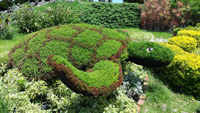
I don’t think I’ve mentioned this but I really like turtles.
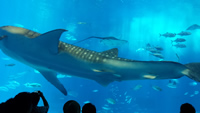
Whale sharks are kinda cool too I guess.
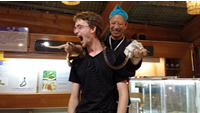
I’m trying to get the snakes back for scaring me in Matsushima Bay.
Research Update
I have finished extending to the double interface system from the work I did in solving the dispersion relation for the single interface system. All the concepts are the same, but the arithmetic was significantly more difficult. Next, I will be taking the conditions for the upper interface and replacing them with the equations for a metal, while putting in the conditions for graphene in the lower, and thus solve for the case of a graphene-metal system. Hopefully from this I will be able to get a result that shows the slowing of the group velocity of surface plasmons.e?
The only real set back I had was that I had to call in sick on Wednesday, and though I was good enough to come in Thursday, I still had a pretty bad headache and it definitely affected my ability to make progress on the arithmetic intensive work I was trying to complete and I made a couple of mistakes I had to go back and fix the next day.
The articles we were provided gave some detail on the downfall of the Japanese female researcher, Obokata. Obokata was a relatively famous stem-cell researcher in Japan. After releasing a certain article on stem cells, she was accused of falsifying data. Following these suspicions, her reputation was attacked, pretty brutally, by newspapers and other scientists. After being investigated, she was found guilty of research misconduct. Obokata still insisted that any errors or misinformation was not intentional.
Falsifying data is, of course, pretty much the greatest sin a scientist can commit in their field. Doing so is an unfair way of gaining recognition without the work to back it up. Even worse, it actually hinders the advancement of research, as the incorrect results essentially lead to wasted time of others as they try to build off of work that isn’t a solid foundation to start with, and they end up having to go back and question the original research in an attempt to verify it.
I think that in this particular case, I think the issue was partially caused by a combination of gender and pressure to publish. Obokata was one of the only prominent females in the research community in Japan. She probably felt the need to distinguish herself from her colleagues in order to feel validated, as well as to set an example for aspiring young Japanese women. I would assume that she was getting fed up with the hit-or-miss nature of research success, and she thought that her only chance was to force a “breakthrough” by falsifying the data.
My reaction to this story, as it is to most stories of misconduct, is one of disappointment. While those who are guilty of misconduct almost certainly had no ill intentions for the rest of us, their actions actually set us back more than if they had just taken a break from the stress of research.
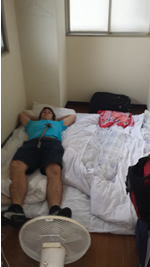
This weekend we went stayed in Osaka and visited Kyoto. Vernon and I were quite surprised at the size of our “double” room.
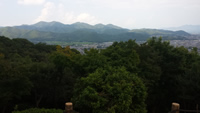
Kyoto was a very beautiful place. Even outside of the temples, the scenery was great!
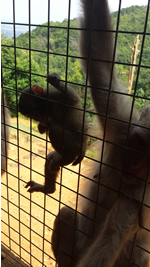
ERMAHGERD BABEH MUNKEH. KAWAII DESU NE. I got to feed it some apples, it was great.
Resaerch Update
I have pursued the route of making an RLC circuit analogy to the case of graphene. We have been looking at the quantum capacitance and inductance of graphene, and trying to account for the speed of plasmons in this way. We have already solved the equation of how to get the plasmon speed based on these values, but when we insert theoretical values for graphene and plug in the dimensions used in the experimental paper we are trying to explain, the results still don’t match. For the time being, I will be focusing and writing the abstract and making the poster ( I didn’t have time last week unfortunately), as well as making a presentation for the Saito group to be presented this Thursday. After this, we will try to see if the results are changed by inserting values of capacitance and inductance that account for abnormalities in the graphene structure.
No real setbacks, but I will be very busy in the coming week as I try to juggle both continuing research and preparing presentations and the poster for Thursday. Nothing else to add at this time. I will include my Saito lab presentation in the report next week.
I didn’t get a chance to ask these specific questions in person, so I asked via skype. My Japanese buddy gave me the following responses:
What is your degree? Master 1
Why did you decide to study these fields? I’m interested in condensed matter physics especially electron state in graphene.
What is it like to be a student in Japan? I think Japanese student study hard.
What is your career path? I’d like to work in a company using what I learned here.
What is the nature of your work environment in the lab? There are many foreign students, and good communications.
How do you think that a lab in Japan differs from the US? I don’t have specific idea because I’ve never been to the US lab.
What is your international experience? This lab is the first experience for me to meet foreigners.
How many international researchers work in your lab? Many (I don’t know specific number)
How has the internationalization of research impacted your work? Discussing with foreign students have been inspiring me.
What are you interested to know about me and the US? How to learn physics during university.
I responded by talking about how the physics curriculum in America works, as well as shared my own experience working in an American physics lab.
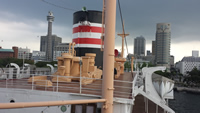
This weekend we went to Yokohama to visit Ramya’s relatives. We also got to see a boat!
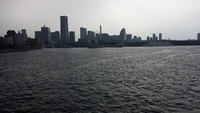
The area was quite pretty.
Research Update
So in the end we have been unable to explain the difference in velocities, so for the poster and presentation, I will be concentrating on the equations I made to model plasmons in other graphene configurations.
Last week we realized the method of looking into charge impurities to explain the slower plasmon velocity wouldn’t work. We were hoping this term could be used to adjust the quantum capacitance value and thus give us a higher velocity in the RLC circuit analogy. However, after adding in the term we found that the impurities would only increase quantum capacitance, while it would need to decrease it in order for the velocity to slow down. We’ve decided to focus on what I have done already for the RQI poster.
I will be keeping in touch with Stanton-sensei for advice for the poster. I am currently still making revisions that were suggested by Saito-sensei.
I feel like my perception that has changed the most is simply my understanding of the vastness of Japan. Previously I had thought of Japan’s culture as being fairly straight forward, and, while very different from what I am used to, easy to comprehend. I was quite wrong. Japan’s culture is just as multi-faceted as our own, if not more. There is a lot of interesting interplay between Japan’s work culture, nightlife culture, and otaku culture, each of which is very different.
As this isn’t my first time abroad, there haven’t been any huge realizations about my own culture, but this trip definitely offered me a new perspective. There are many things that I took for granted, such as large serving sizes, people being mostly self-serving rather than helpful, and English fluency. I also assumed many things. For example, I had assumed the US was among the most advanced or at least not too far behind in things such as transportion, but Japan’s metros and shinkansen system really opened my eyes.
Well, other than the fact I’m going to be accidentally bowing to people I meet out of pure habit for the coming months, I feel I have become a little more understanding of what it is like to be in a foreign country where the spoken language is not your native language. I feel I can relate much more to international students who struggle with English, and have learned how to better help them understand what I am trying to say.
The most common daily frustration was ordering food. Any time we go to a restaurant, they usually don’t have an English menu (at least in Sendai), so finding what to eat is a bit of a struggle. Thankfully, I am not a vegetarian, nor do I have any food allergies, so even if I have to resort to ordering something random, I can still consume it. Whether I can keep it down or not is another matter entirely.
I think the number one thing I will miss are the people I have met. Both my lab mates and the other NanoJapan students are the component that have made this experience truly wonderful, and it wouldn’t have been nearly as great without them. Next, I will most definitely miss the food. Japan has a plethora of delicious and healthy food to eat, despite a few hiccups *cough cough* natto *cough cough*. I will especially miss being able to do the majority of my shopping at a combini near to where I live.
Getting to work on a theory project has been a great experience. Although it has been very tough, I have found it extremely rewarding, and I definitely prefer it over the kind of experimental lab work I have conducted thus far.
My final week in the lab was a scramble to finish up my poster and finish any other work I had been doing for my mentor. During this time, I was largely fending for myself since the rest of the lab was preparing for a conference, but my mentor Shoufie-san still put in a considerable amount of time making sure everything was going alright. We had my going away party that Wednesday, and I was asked to give a short speech, so I thanked all the lab members and we had a very heartfelt parting.
My research project ended up reaching a dead end where we were still struggling to explain the differences in velocities between theory and experiment. I am still in contact with Shoufie-san, but it doesn’t seem like we will do any more work on the project.
For my final weekend in Japan, I went on the Fuji hike. I was one of the ones that actually made it to the top. I was with Ramya and Skylar, and we finished at about 2:45 in the morning. I was extremely exhausting, but was easily the most beautiful sight I got to experience during my time in Japan. I will include photos of Fuji-san.
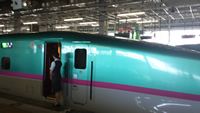
Here’s a picture of the train that is taking us back to Tokyo. :(
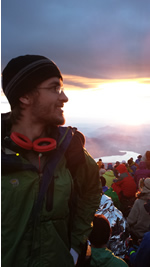
This is me on top of Mount Fuji with an absolutely stunning view of the sunrise.
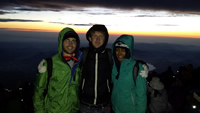
This is three of us on top of Fuji right as it started to get light out. The sun hasn’t risen yet.
Tokyo Research Symposium
The Tokyo Research Symposium was a great way to conclude our time in Japan. It was great getting to tell everyone about how we spent our summer, and describing the research we got to do. I was a little disappointed with the short amount of time we get for the presentation, but I understand we need to make time for the panel discussion and the other speakers as well. Speaking of, the panel discussion was the most interesting part for me. It was great hearing from Nicole and Chris, as well as the other panel guests.
Final Research Project Overview
Research Project Title: ![]()
Research Lab and Host Profesor:Saito Lab, Prof. Riichiro Saito, Tohoku University
Research Mentors: Shoufie Uhktary and Eddwi Hasdeo
Introduction: This project’s goal is to investigate the characteristics of plasmons in different configurations of graphene systems. Graphene has many interesting electrical properties, and since plasmons are waaves created by electron oscillations, it follows that plasmons in graphene should have interesting properties as well. Plasmons have uses in various types of communications applications.
Approach: To investigate the plasmons, we used Maxwell’s Equations along with boundary conditions to derive the plasmon dispersion relation, which is the plasmon’s frequency as a function of wavevector. We then take the derivative of this with respect to wavevector to find the plasmon’s velocity in the graphene.
Results: We found the plasmon’s frequency for most typical (small) wavevectors to fall in the terahertz range. In addition, the plasmon’s velocity is very high, around 10^7 m/s, just one order of magnitude below the speed of light.
Discussion: Plasmons with frequencies in the terahertz range are ideal for certain types of equipment such as modulators. In addition, the extremely high velocity is great for any kind of signal transfer, as this improves the speed at which information can be taken from point A to point B.
Future Research: The next steps for the research project involve looking into a few more factors. For example, it would be interesting to see what would happen if we significantly decreased the separation of graphene layers for the double graphene interface, in order to increase the effect of coupling. Also, more investigation of the Metal-Graphene Interface is needed, as the theoretical velocity doesn’t match up with what has been found in experiments. Although we have already put a lot of effort into trying to explain this, more work is needed.
Conclusion: In the end, we find that plasmons in graphene have very convenient properties. Because of a high velocity and a good range of frequencies, these systems have a lot of potential in information transfer.
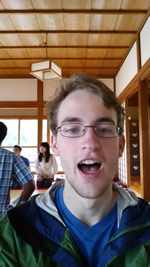
One of the best parts of the NanoJapan program is that it gave a multifaceted experience. It was equal parts research, culture exploration, bonding, and general fun. No matter how you look at it, there is something there to interest anyone.
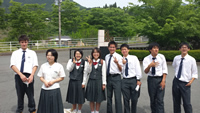
When speaking to a family member, I tell them about how much I’ve learned of Japan’s culture. My first highlight of course is our trip to Kyushu. Getting to meet the both the high school students, kindergarten children, and homestay families was a wonderful and eye-opening experience. In all of these cases, I learned about their culture using actions rather than words. With the high school students, they showed us how to make the traditional shoes out of leaves, and we shared some of our culture by having a small science competition with magnets. With the kindergarteners, we shared in singing, dancing, and laughter as we played different children’s games. With the homestay families, we shared meals and stories, and went to see much of the local area. I would also tell my family about work life in Japan, and how hard working my lab members were, as well as how much fun we would have together every week playing ping pong or going to karaoke together.
When speaking with a professor about my time in Japan, I would mostly speak about my research experience and other relevant information. For example, I would tell them I worked on a theory project where I modeled the distribution relations and velocities of plasmons in different graphene systems, and that I also looked into why the current theory predicts a faster speed for plasmons in a graphene-metal system than has been found in experiment. If they were curious, I would also talk about how I went about studying this. I used Maxwell’s equations and factored in the boundary conditions for graphene to find the dispersion relation, and used Mathematica for making plots of these. I also made an analogy between the plasmons in the graphene-metal system and a resistor-inductor-capacitor (RLC) circuit, and explored velocity as a function of inductance and capacitance. I would also mention that it was very interesting getting to work in a Japanese lab setting as opposed to an American one. For example, the rigid structure of the lab hierarchy was something that took some getting used to.
When speaking with a potential employer, I would emphasize that the NanoJapan program was an experience where I had to adapt. Everything was unfamiliar and completely different from how I was used to operating. Daily tasks like ordering food could be a challenge due to the language barrier. In addition, the majority of my lab members were not Japanese, nor were they American. They were from various parts of the world, such as Brazil, Indonesia, China, and Iran. With all of us together, I had to adjust, not just to communicate, but to be able to get along well with everyone. I put in some effort and I eventually got the hang of recognizing the mannerisms of my different lab members, and made myself a contributing member of the group.
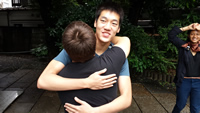
Finally, when talking to a fellow student, I would speak about how much of a blast Japan was. Looking back at it, spending three months there has been just a CRAZY wild experience. Our three week orientation in Tokyo is filled with exploration of all of Tokyo’s most famous districts. There was not a single wasted day in those first three weeks. Every night there was something new and exciting to go see or do, from finding the Pokemon Center, to seeing Tokyo Tower, and of course exploring Akihabara and its many maid cafes and otaku merchandise stores. Next is of course the food. Japan has a lot of great food that the average American would question the edibility of, such as plenty of raw fish sushi, eel, squid, horse meat, and my personal favorite, cow tongue. By about this time the student is probably starting to regret coming into such a long conversation with what seems to have turned out to be one of those crazy people you always hear about on the news, so rather than starting to go through a 1000 picture slideshow on my phone with commentary, I tell them they should consider applying, and that they should also look into study abroad programs in whatever region they are interested in.
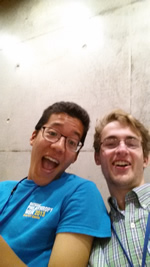
I’ve always been a very relaxed and “chill” person, and this often meant I wouldn’t go very far to put in effort to get involved in many things. However, during my time in Japan, I started trying to adopt a ‘seize the day’ kind of attitude, trying to make the most out of every experience, because I knew that if I just did what I usually do at home, I wouldn’t really get out of my comfort zone and I wouldn’t get to REALLY experience Japan. This wasn’t an overnight absolute change, of course, but I really am happy with what I did and feel I made the most of my limited time in Japan. And now that I’m back in the States, I find I don’t really want to go back to that overly relaxed attitude. My time in Japan made me realize there is a lot I have left to explore. Even in Houston, I have very little knowledge of what there is to do outside of Rice and Rice Village, so I want to start getting out more, perhaps by getting involved in some extra curricular programs or helping by doing community service. It’s been hard staying active, and especially in my first week back in America I’ve caught myself slipping, but I’ve been making a struggle to keep up and stay active.
I suppose my last question about Japan is: When can I go back? I would love to return one day, and though I doubt it will be very soon, it’s something I hope to do in the future. Perhaps I can make it back to Tokyo for the 2020 Olympics. In the meantime, I’d also like to explore other Asian countries, like China, Taiwan, Indonesia, and Korea.